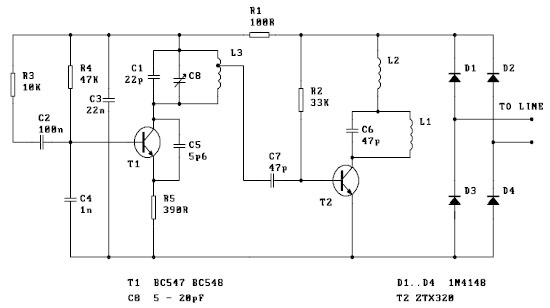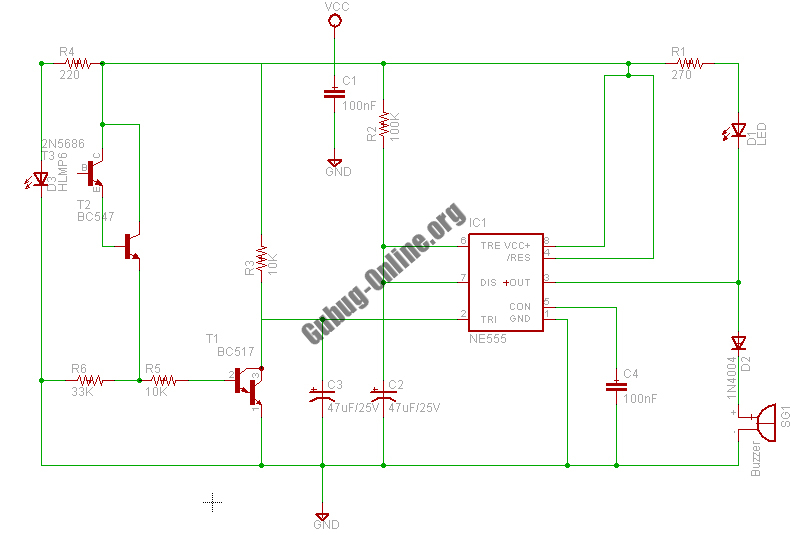
Spy Phone Bug Transmitter Circuit

This is a basic telephone broadcaster or transmitter designed for eavesdropping on telephone conversations. The circuit can also function as a wireless telephone amplifier. A key feature of this phone transmitter is that it derives its power directly from the active telephone lines, eliminating the need for external batteries or power supplies. This design not only conserves space but also reduces costs. It consumes minimal current from the telephone lines without affecting performance. The phone bug transmitter is compact and can be assembled using a single IC on a veroboard, fitting easily inside a telephone connection box measuring 3.75 cm x 5 cm. The automatic switching section includes resistors R1 to R3, a preset VR1, transistors T1 and T2, a zener diode D2, and a regular diode D1. Resistor R1, in conjunction with preset VR1, functions as a voltage divider. When the voltage across the telephone lines is 48V DC, the voltage at the wiper of preset VR1 can be adjusted from 0 to 32V. The switching voltage of the circuit is determined by the zener breakdown voltage and the switching characteristics of transistor T1. By adjusting preset VR1 to exceed 24.7 volts, the zener diode breaks down, causing transistor T1 to conduct. Consequently, the collector of transistor T1 is pulled towards the negative supply, turning off transistor T2. If the telephone handset is lifted, the line voltage drops to approximately 11V, which cuts off transistor T1. This allows T2 to become forward biased through resistor R2, providing a DC path for transistor T3, which is part of the FM transmitter section. The low-power FM transmitter section consists of oscillator transistor T3, coil L1, and several other components. T3 operates as a common-emitter RF oscillator, while T2 acts as an electronic switch. The audio signal from the telephone lines automatically modulates the oscillator frequency through T2 and its biasing resistor R3. The modulated RF signal is then transmitted to the antenna, enabling the telephone conversation to be heard on a remote FM receiver tuned to the transmitter frequency.
This telephone broadcasting circuit employs a simple yet effective design to enable eavesdropping on conversations. The automatic switching mechanism integrates various components, ensuring low power consumption while maintaining functionality. The use of a voltage divider formed by resistors R1 and VR1 is critical for controlling the operational state of the transistors. The zener diode plays a pivotal role in regulating the switching voltage, allowing for precise control over the circuit's activation and deactivation based on the telephone line's voltage.
In the FM transmitter section, the common-emitter configuration of transistor T3 allows for efficient modulation of the RF signal, which is essential for transmitting audio signals over a distance. The inclusion of coil L1 aids in establishing the oscillation frequency, further enhancing the circuit's performance. The circuit's compact design enables it to be discreetly integrated into existing telephone infrastructure, making it a practical solution for wireless amplification and monitoring of telephone conversations. The overall design emphasizes efficiency, low power usage, and ease of installation, making it suitable for various applications in telecommunications and audio transmission.A very simple telephone broadcaster or transmitter which can be used to eavesdrop on a telephone conversation. The circuit can also be used as a wireless telephone amplifier. One important feature of this phone transmitter is that the circuit derives its power directly from the active telephone lines, and thus avoids use of any external ba
ttery or other power supplies. This not only saves a lot of space but also money. It consumes very low current from telephone lines without disturbing its performance. The phone bug transmitter is very tiny and can be built using a single -IC type veroboard that can be easily fitted inside a telephone connectin box of 3. 75cm x 5cm. Automatic switching section comprises resistors R1 to R3, preset VR1, transistor T1 and T2, zener D2 and diode D1.
Resistor R1, along with preset VR1, works as a voltage divider. When voltage across the telephone lines is 48V DC, the voltage available at wiper of preset VR1 ranges from 0 to 32V (adjustable). The switching voltage of the circuit depends on zener breakdown voltage and switching voltage of the transistor T1.
Thus, if we adjust preset VR1 to get over 24. 7 volts, it will cause the zener to breakdown and transistor T1 to conduc. As a result collector of transistor T1 will get pulled towards negative supply, to cut off transistor T2. At this stage, if you lift the handset of the telephone, the line voltage drops to about 11V and transistor T1 is cut off.
As a result, T2 gets forward biased through R2 to provide a DC path for T3 used in the following FM transmitter section. The low-power FM transmitter section comprises oscillator transistor T3, coil L1 and a few other components.
T3 works as a common-emitter RF oscillator, with T2 serving as an electronic on/off switch. The audio signal available across the telephone lines automatically modulates oscillator frequency via T2 along with its biasing R3. The modulated RF signal is fed to the antenna. The telephne conversation can be heard on an FM receiver remotely when it is tuned to the transmitter frequency.
🔗 External reference
This telephone broadcasting circuit employs a simple yet effective design to enable eavesdropping on conversations. The automatic switching mechanism integrates various components, ensuring low power consumption while maintaining functionality. The use of a voltage divider formed by resistors R1 and VR1 is critical for controlling the operational state of the transistors. The zener diode plays a pivotal role in regulating the switching voltage, allowing for precise control over the circuit's activation and deactivation based on the telephone line's voltage.
In the FM transmitter section, the common-emitter configuration of transistor T3 allows for efficient modulation of the RF signal, which is essential for transmitting audio signals over a distance. The inclusion of coil L1 aids in establishing the oscillation frequency, further enhancing the circuit's performance. The circuit's compact design enables it to be discreetly integrated into existing telephone infrastructure, making it a practical solution for wireless amplification and monitoring of telephone conversations. The overall design emphasizes efficiency, low power usage, and ease of installation, making it suitable for various applications in telecommunications and audio transmission.A very simple telephone broadcaster or transmitter which can be used to eavesdrop on a telephone conversation. The circuit can also be used as a wireless telephone amplifier. One important feature of this phone transmitter is that the circuit derives its power directly from the active telephone lines, and thus avoids use of any external ba
ttery or other power supplies. This not only saves a lot of space but also money. It consumes very low current from telephone lines without disturbing its performance. The phone bug transmitter is very tiny and can be built using a single -IC type veroboard that can be easily fitted inside a telephone connectin box of 3. 75cm x 5cm. Automatic switching section comprises resistors R1 to R3, preset VR1, transistor T1 and T2, zener D2 and diode D1.
Resistor R1, along with preset VR1, works as a voltage divider. When voltage across the telephone lines is 48V DC, the voltage available at wiper of preset VR1 ranges from 0 to 32V (adjustable). The switching voltage of the circuit depends on zener breakdown voltage and switching voltage of the transistor T1.
Thus, if we adjust preset VR1 to get over 24. 7 volts, it will cause the zener to breakdown and transistor T1 to conduc. As a result collector of transistor T1 will get pulled towards negative supply, to cut off transistor T2. At this stage, if you lift the handset of the telephone, the line voltage drops to about 11V and transistor T1 is cut off.
As a result, T2 gets forward biased through R2 to provide a DC path for T3 used in the following FM transmitter section. The low-power FM transmitter section comprises oscillator transistor T3, coil L1 and a few other components.
T3 works as a common-emitter RF oscillator, with T2 serving as an electronic on/off switch. The audio signal available across the telephone lines automatically modulates oscillator frequency via T2 along with its biasing R3. The modulated RF signal is fed to the antenna. The telephne conversation can be heard on an FM receiver remotely when it is tuned to the transmitter frequency.
🔗 External reference





